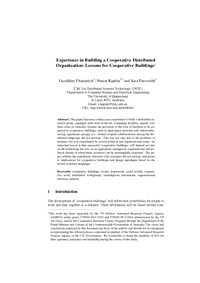Experience in Building a Cooperative Distributed OrganizationLessons for Cooperative Buildings
Geraldine Fitzpatrick, Simon M. Kaplan, Sara Parsowith
Publikationsdatum:
Zu finden in: Cooperative Buildings: Integrating Information, Organization, and Architecture (Seite 66 bis 79), 1998
|
 |
 Diese Seite wurde seit 5 Jahren inhaltlich nicht mehr aktualisiert.
Unter Umständen ist sie nicht mehr aktuell.
Diese Seite wurde seit 5 Jahren inhaltlich nicht mehr aktualisiert.
Unter Umständen ist sie nicht mehr aktuell.
 Zusammenfassungen
Zusammenfassungen
This paper discusses a three-year experiment to build a distributed research group, equipped with state-of-the-art computing
facilities, spread over three cities in Australia. Despite the provision of the sorts of facilities to be expected in cooperative
buildings, such as high-speed networks and videoconferencing, significant synergy (i.e., closely-coupled collaborations) among
the distributed subgroups did not develop. This was not only due to the problems of distance, but was exacerbated by several
political and organizational issues. An important lesson is that successful ‘cooperative buildings’ will depend not just on
the technology but also on an appropriate managerial, organizational and political climate in which these resources can be
meaningfully exploited. The paper outlines the experiment, discusses why synergies did not emerge, and points to implications
for cooperative buildings and design paradigms based on the notion of pattern languages.
Von Geraldine Fitzpatrick, Simon M. Kaplan, Sara Parsowith im Konferenz-Band Cooperative Buildings: Integrating Information, Organization, and Architecture im Text Experience in Building a Cooperative Distributed Organization (1998)  Dieses Konferenz-Paper erwähnt ...
Dieses Konferenz-Paper erwähnt ...
 Begriffe KB IB clear | SerendipitySerendipity |
 Volltext dieses Dokuments
Volltext dieses Dokuments
 |  Experience in Building a Cooperative Distributed Organization: Artikel als Volltext bei Springerlink ( Experience in Building a Cooperative Distributed Organization: Artikel als Volltext bei Springerlink ( : :  , 70 kByte; , 70 kByte;  : :  Link unterbrochen? Letzte Überprüfung: 2021-03-21 Letzte erfolgreiche Überprüfung: 2019-10-11) Link unterbrochen? Letzte Überprüfung: 2021-03-21 Letzte erfolgreiche Überprüfung: 2019-10-11) |
 Anderswo suchen
Anderswo suchen 
 Beat und dieses Konferenz-Paper
Beat und dieses Konferenz-Paper
Beat hat Dieses Konferenz-Paper während seiner Zeit am Institut für Medien und Schule (IMS) ins Biblionetz aufgenommen. Beat besitzt kein physisches, aber ein digitales Exemplar. Eine digitale Version ist auf dem Internet verfügbar (s.o.). Aufgrund der wenigen Einträge im Biblionetz scheint er es nicht wirklich gelesen zu haben. Es gibt bisher auch nur wenige Objekte im Biblionetz, die dieses Werk zitieren.









 Biblionetz-History
Biblionetz-History